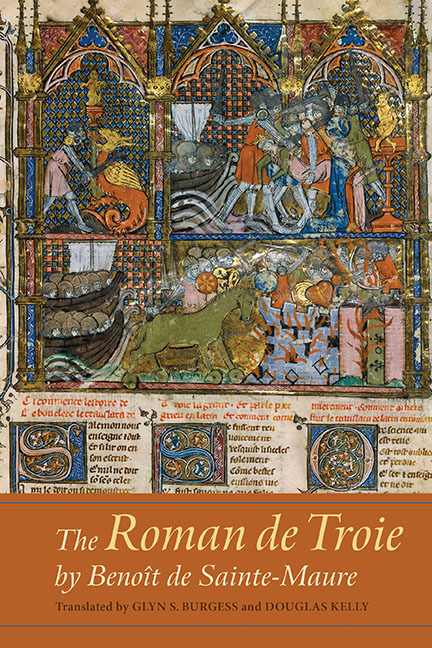Book contents
- Frontmatter
- Contents
- Dedication
- Preface and Acknowledgements
- Introduction
- A Note on the Translation
- Outline of the Roman de Troie
- The Roman De Troie
- Part One Causes and Effects
- Part Two The Trojan War
- Part Three Settling Scores and Surviving
- Appendix I Notes on Some Common Words in the Roman de Troie
- Appendix II Manuscripts of the Roman de Troie
- Bibliography
- Indexes of Personal and Geographical Names
- Index of Personal Names
- Index of Geographical Names
- Miscellaneous Endmatter
Preface and Acknowledgements
Published online by Cambridge University Press: 15 February 2018
- Frontmatter
- Contents
- Dedication
- Preface and Acknowledgements
- Introduction
- A Note on the Translation
- Outline of the Roman de Troie
- The Roman De Troie
- Part One Causes and Effects
- Part Two The Trojan War
- Part Three Settling Scores and Surviving
- Appendix I Notes on Some Common Words in the Roman de Troie
- Appendix II Manuscripts of the Roman de Troie
- Bibliography
- Indexes of Personal and Geographical Names
- Index of Personal Names
- Index of Geographical Names
- Miscellaneous Endmatter
Summary
The present translation of Benoît de Sainte-Maure's Roman de Troie is meant to foster a greater appreciation of this early French romance, which is one of the works known as the romans d'antiquité. We hope to provide the basis for further study of the Troie in its own right, as well as of its relationship with other authors and with literary and historical works in the Middle Ages and beyond. The legend of Troy has been a direct or indirect source for numerous rewritings that began to appear in antiquity and continued into the twelfth century when the Troie was written. Composed in Latin, French and other vernacular languages, many of these later works were influenced by, or modelled on, all or parts of Benoît's poem. Moreover, a number of new versions continued to exploit Benoît's work for a long time after the period in which he wrote. The love of Briseida produced some remarkable rewrites, as Cressida in Boccaccio's Il Filostrato, Criseyde in Chaucer's Troilus and Criseyde and Cresseid in Henryson's Testament of Cresseid, culminating in Shakespeare's Troilus and Cressida. These rewritings are not translations, but rather adaptations, in fresh contexts, media and narrative modes, of the Troilus–Briseida–Diomedes triangle first found in the Troie, but with different emphases and evaluations. Benoît invented Briseida's change of heart, something that slowly transpired over almost two years of hesitation, a change that Benoît and Briseida herself admit would be controversial. These later rewritings of her story bear out Horace's claim in his Art of Poetry (quoted in our epigraph) that poets would do better to show originality by writing a new version of the Trojan War than by producing something on an entirely new topic. This is obviously also relevant for the new versions of Briseida's loves, and not only because of her altered name. If authors heeded this dictum, Benoît might be considered as a more original twelfth-century French poet than has been recognized by those who have read with some dismay the twenty-three battles that occupy so many lines of his work.
- Type
- Chapter
- Information
- The Roman de Troie by Benoît de Sainte-MaureA Translation, pp. vii - viiiPublisher: Boydell & BrewerPrint publication year: 2017

